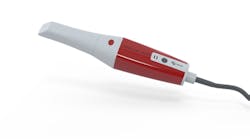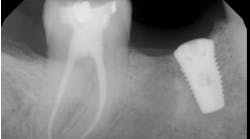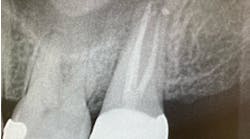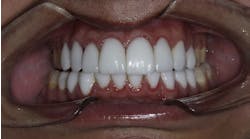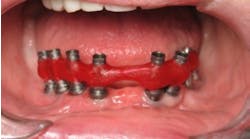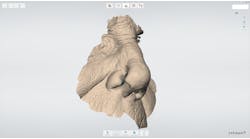Making accurate dental impressions when faced with anatomical challenges: mandibular tori
The dental impression provides the critical information needed for predictable long-term outcomes and time-savings at time of delivery. The unique properties of the impression material you use can aid in making that accurate impression, especially when faced with anatomical challenges such as mandibular tori. In the case discussed in this article, it was decided to try the new Virtual XD wash materials with thixotropic properties that made capturing an accurate impression both efficient and precise, providing the extra definition needed to read the margins, while releasing over the tori when removed. Properly designing a customized disposable tray can play an important role.
RELATED READING |Orthodontic aligner impressions made easy
When using a heavy/light dual-phase impression technique
Firstselect an impression tray and evaluate the fit. Heat the plastic tray to modify as needed, such as below in Fig. 1 to avoid mandibular tori interference with the tray. Also add wax where needed for extension or filling in of the palate on the upper arch as a tray seating stop and to equalize relief for impression accuracy. Apply tray adhesive ahead of the appointment to all areas that will come into contact with the impression material. This provides time to dry for better adhesion. Load two cartridge dispensers, one with Virtual XD wash material and one with Virtual XD tray material. For the upper arch, consider Damit from Affordable Dental Products, to control palatal flow of the material and prevent gagging (Fig. 2). The Virtual Mixer for 380 ml cartridges is a great alternative to traditional hand dispensers for tray material, is much easier on your assistants, and helps create consistency in timing loading of the tray. When all cartridges are being loaded, make sure you bleed the cartridge to verify an even flow of base and catalyst prior to applying the mixing tip. Not bleeding it could cause an uneven amount of base and catalyst and cause the impression not to set properly.
Fig. 2A: Customized upper tray with Damit
Fig. 2B: Customizing upper tray for open tray implant transfer and precise palatal positioning for implant screws.Isolate and dry the area that is going to be impressed (Fig. 3). While extruding the wash material around the preparation, it’s important to keep the tip buried to prevent voids or air pockets. When extruded, the thixotropic properties of the wash material allows the material to stay on the preparation and not flow all over the patient’s mouth (Fig. 4).
Fig. 3: Dry the preparation area that is going to be impressed.
Fig. 4: Extruding Virtual XD onto the preparation and note thumb support and guidance for controlled rapid delivery.Insert the tray far enough into the mouth so you can seat it straight up or down over the teeth (Figs. 5 and 6). When the tray material is placed, the material starts to penetrate and flow deep into the sulcus, capturing the necessary detail. Hold the tray in place for the minimum set time, which can range from 2-and-a-half minutes for fast set to 4-and-a-half minutes for regular set with this material. After the set time, check the material to verify the tray material has set and remove the tray very slowly, not from the handle, but rather first breaking posterior seal. This is especially important with double cord technique to avoid marginal tears from possible cord attaching to material.
Fig. 5: Seating the tray intraorally.
Fig. 6: Hold the tray so no movement occurs during the set time.Carefully inspect the impression with your magnifiers and overhead light or head lamp. Confirm all margins are readable (Figs. 7 and 8).
Fig. 7: Final impression
Fig. 8: Final impression
Virtual XD impressions maintain their dimensional stability for up to two weeks. All impressions should be rinsed, dried, and disinfected before sending them to the laboratory.











